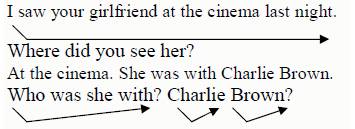The fall-rise pattern (yes/no questions, requests for repetition, greetings)
The main movement in the sentence is still on the Tonic syllable, but this time the voice falls on the Tonic and then rises. You use this pattern to ask questions that require an answer of "Yes" or "No".



Did you notice that the second pattern is, in fact, not the exact reverse of the first? In the statement, once the voice has fallen after the Tonic, it stays at the same level, but in the question the voice continues to rise to the end of the sentence. Be careful not to rise too sharply, especially if you have a lot to add after the Tonic, or you'll end up in a squeak!

The fall-rise pattern is also used for greetings, the voice rising and falling on the greeting, and then, on the name that follows falling a little more and rising again sharply.

You also use this tune with "wh-" questions when you're asking for information to be repeated. The intonation here usually expresses shock or anger, implying, "I don't believe you!"

Intonation III
(pausing in the middle, lists, doubt, apology, etc.)
Intonation is one of the means a speaker uses to send signals to the listener, such as "Don't interrupt me; I haven't finished yet", or "That's all for the moment. Over to you." If the speaker pauses in the middle of a sentence, he will stop on a rising tone to show you that he intends to continue.

In the first part of the sentence, up to the pause, the pattern is the ordinary rise-fall one of statements, until you come to the Tonic, which has the fall-rise tune. This fall-rise only on the Tonic is frequently used to express doubt, hesitation or apology. It can also imply, ,,Can I help you?"

You use the fall-rise tune, too, when enumerating lists. Every items on your list will have its own pattern, each one on the same level as the last:

If your list is complete, the final item will have the rise-fall pattern, indicating to your listener that that's the lot. This is called a "closed" list:

If you want to show that you could go on but leave the rest to your listener's imagination, you use the fall-rise pattern on the last item as well. This is called "open" list:

This implies questions, too: Are you free on Monday or Tuesday or Wednesday..? If you go to India / you must see the Taj Mahal.

We went to Rome and Athens and Beirut and Cairo.
I can offer you tea or coffee or hot chocolate.
Ритм предложения.
Группа слогов, состоящая из одного ударного слога и окружающих его неударных слогов, называется ритмической или акцентной группой. Эта группа должна произносится максимально слитно, как одно многосложное слово.
В английской речи неударные слоги, стоящие между ударными, в общем имеют тенденцию примыкать к предшествующему ударному слогу. Однако они примыкают к последующему ударному, когда стоят в начале смысловой группы или в тех случаях, когда необходимо подчеркнуть смысловую связь неударного слова с последующим ударным.
Ритм английской речи характеризуется тенденцией чередовать ударные слоги смысловой группы с неударными и произносить эти ударные слоги через более или менее равные промежутки времени.
Скорость произнесения безударных слогов зависит от того, сколько безударных слогов находится между двумя ударными: чем их больше, тем выше скорость их произнесения. Поэтому безударные слова в английской речи едва воспринимаются на слух иностранцем.
Каждая смысловая группа имеет свой собственный ритм зависящий от степени смысловой нагрузки, по сравнению с другими смысловыми группами высказывания.
Соблюдение подобного, чисто английского ритма речи, достигается слитным, без паузы, произнесением безударных слогов с последующим ударным слогом в пределах одной ритмической группы. Вдох в разговорной речи делается только между ритмическими группами, а внутри все слоги произносятся "на одном дыхании".
Слитно читаются следующие сочетания слов:
1. артикль, местоимение, предлог + существительное (возможно с определением к нему):
aÈbook, theÈdesk, thisÈbook, myÈoldÈbag, byÈtheÈcar, nearÈtheÈtown, onÈtheÈlargeÈtable
Частица to с инфинитивом
toÈbe, toÈmake, toÈtake
